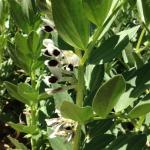Growing Broad Beans, also Fava bean
Vicia faba : Fabaceae / the pea or legume family
| Jan | Feb | Mar | Apr | May | Jun | Jul | Aug | Sep | Oct | Nov | Dec |
|---|---|---|---|---|---|---|---|---|---|---|---|
| P | P | P | P |
(Best months for growing Broad Beans in New Zealand - cool/mountain regions)
- P = Sow seed
- Easy to grow. Sow in garden. Sow seed at a depth approximately three times the diameter of the seed. Best planted at soil temperatures between 43°F and 75°F.
- Space plants: 6 - 10 inches apart
- Harvest in 12-22 weeks. Pick frequently to encourage more pods.
- Compatible with (can grow beside): Dill, Potatoes
It is a rigid, erect plant 0.5 - 1.7 m tall, with stout stems with a square cross-section. The leaves are 10 - 25 cm long, pinnate with 2 - 7 leaflets, and of a distinct glaucous grey-green color. Harvest 90 - 160 days depending on how cold the weather is.
In windy areas it is best to provide some support with posts and string, otherwise the plants will fall across each other. Pick the tops out once beans start setting to prevent blackfly.
Culinary hints - cooking and eating Broad Beans
The fresh beans are eaten steamed or boiled. As the beans mature it is better to remove their tough outer skins after cooking.
The leafy top shoots of the adult plants can be picked and steamed after flowering.
Small beans can be eaten whole in the pods.
Broad beans will freeze well. Remove from pods and blanch.






Your comments and tips